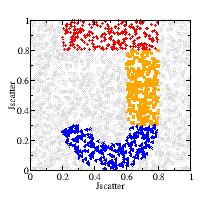Combines dataArrays with attributes for fitting plotting and analysis including models for Xray and neutron scattering
Project description
The aim of Jscatter is treatment of experimental data and models:
Reading and analyzing experimental data with associated attributes as temperature, wavevector, comment, ….
Multidimensional fitting taking attributes into account.
Providing useful models for neutron and X-ray scattering form factors, structure factors and dynamic models (quasi elastic neutron scattering) and other topics.
Simplified plotting with paper ready quality.
Easy model building for non programmers.
Python scripts/Jupyter Notebooks to document data evaluation and modelling.

Main concept
Data are organised in dataArray/dataList with attributes as .temperature, .wavevector, .pressure and methods for filter, merging and more.
Multidimensional, attribute dependent fitting (least square Levenberg-Marquardt, Bayesian fit, differential evolution, …).
Provide relative simple plotting commands to allow a fast view on data and possible later pretty up.
User write models using the existing model library or self created models.
The model library contains routines e.g. for vectorized quadrature (formel) or specialised models for scattering as formfactor, structurefactor, dynamic and biomacromolecules.
Documentation
Documentation located at http://jscatter.readthedocs.io. A number of examples how to use Jscatter is provided and can be run from Jscatter.
A short example how to use Jscatter
import jscatter as js
i5=js.dL(js.examples.datapath+'/iqt_1hho.dat') # read the data (16 sets) with attributes
# define a model for the fit
diffusion=lambda A,D,t,wavevector,elastic=0:A*np.exp(-wavevector**2*D*t)+elastic
# do the fit
i5.fit(model=diffusion, # the fit function
freepar={'D':[0.08],'A':0.98}, # start parameters, "[]" -> independent fit
fixpar={'elastic':0.0}, # fixed parameters
mapNames={'t':'X','wavevector':'q'}) # map names from the model to names from the data
p=js.grace(1.2,0.8) # open a plot
p.plot(i5,symbol=[-1,0.4,-1],legend='Q=$q') # plot with Q values in legend
p.plot(i5.lastfit,symbol=0,line=[1,1,-1]) # plot fit as lines
p.save('test.agr')
** Released under the GPLv3 **
Project details
Release history Release notifications | RSS feed
Download files
Download the file for your platform. If you're not sure which to choose, learn more about installing packages.


















